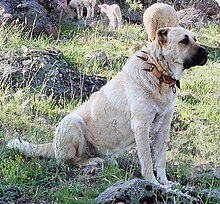Spiked collar
A spiked collar , also called a coral collar or claw collar , is a collar that was used in the past in dog training and is still used in some cases today. For reasons of animal welfare , its use is explicitly prohibited in Austria - with the exception of service dogs from government agencies - and Switzerland. In Austria, according to Section 5, Paragraph 4 of the Federal Animal Protection Act (apart from exceptions for service dogs), the placing on the market, acquisition and possession of spiked and coral collars are also prohibited.
In the Federal German Animal Welfare Act it is generally stated:
“It is forbidden […] 1b. to apply measures to an animal in training […] that are associated with considerable pain, suffering or damage […], […] 5. to educate or train an animal if this is associated with considerable pain, suffering or damage for the animal [.] "
In the course of the discussion of a petition against sting necks in Germany on November 5, 2012, the Parliamentary State Secretary in the Federal Ministry of Food, Agriculture and Consumer Protection Peter Bleser stated in the Petitions Committee that the use of spiked collars could in individual cases on the basis of Section 3 No. 5 Animal Welfare Act of the enforcement authorities are prevented and punished with a fine of up to 25,000 €. Furthermore, in numerous test regulations for dog sports, the use of spiked or choke collars of any form is prohibited. Many clubs also expressly prohibit their use on their systems.

Originally, the terms, which are now largely used synonymously, were distinguished from one another. In 1921 Max von Stephanitz wrote in his work The German Shepherd Dog in words and pictures :
“The simplest school collar is a wide leather choke collar with spikes, spiked collar. The coral collar consists of a row of wooden eggs that can move around themselves and are studded with spikes; it has a sharper effect, but can also damage the hand of the guide if it is picked up quickly. In any case, the coral collar should only be used for training purposes, while the spiked collar can be put on a stormy, poorly leashed dog in all aisles. The school collar 'Torquatus', a spiked nickel-plated chain strangler, has proven itself well; it can be turned around while it is being carried, so that the spines then become ineffective against the dog, although they then again endanger the handler's hands. Wide collars with outwardly pointing sharp spines - actual spiked collars - were often, and are occasionally still, wrapped around guard and guard dogs in order to protect them from the bites of the predator directed against the throat and against attacks by a robber's fist. "
The leather collar described by Stephanitz as a spiked collar with inwardly directed spikes is in trade under the term Oberländer .
Individual evidence
- ↑ Switzerland: Art. 73 and 76 Animal Welfare Ordinance (PDF; 621 kB)
- ↑ a b Austria: Federal Act on the Protection of Animals (Animal Protection Act - TSchG), Section 5
- ↑ Discussion of a petition against spiked collars: Video recording of the Petitions Committee November 5, 2012 (timecode 02: 23: 56-02: 24: 47)
- ↑ Max von Stephanitz: The German Shepherd Dog in words and pictures . Publishing house of the "Association for German Shepherd Dogs (SV)", Munich 1921, p. 583, 584 .
Web links
- Dog photos from Turkey Many pictures show spiked collars with long, sharp, outward-pointing spikes.



